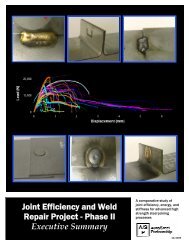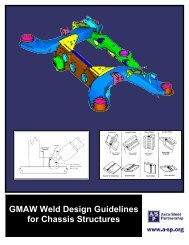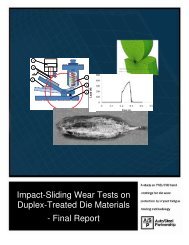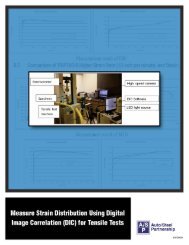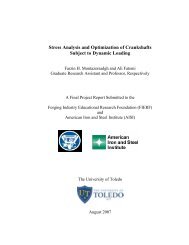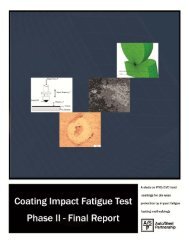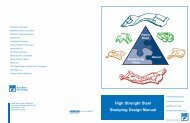Light Truck Frame Joint Stiffness Study Phase 1 Final Report
Light Truck Frame Joint Stiffness Study Phase 1 Final Report
Light Truck Frame Joint Stiffness Study Phase 1 Final Report
You also want an ePaper? Increase the reach of your titles
YUMPU automatically turns print PDFs into web optimized ePapers that Google loves.
JOINT STIFFNESS TOOLBOX<br />
Notes:<br />
* Modify the input values (yellow) based on<br />
your design criteria. There are two columns<br />
in which in to input and evaluate data, case 1<br />
and case 2. The calculated stiffness will be<br />
displayed in red.<br />
* Design variables are listed in order of<br />
influence on stiffness.<br />
Illustration Key:<br />
A = Side Rail<br />
B = Crossmember<br />
Design Rules:<br />
* Make the crossmember diameter as<br />
large as possible.<br />
* Make the crossmember as thick as<br />
possible.<br />
* Thickness and diameter of the<br />
crossmember should be increased<br />
together if possible.<br />
* Click on the animation to the left of the<br />
variables and loading conditions to see an<br />
animation of respective shape variable or<br />
loading condition.<br />
* The mass calculation is based on 150 mm<br />
extension of joint members from the side rail<br />
to crossmember interface. (The crossmember<br />
is 150mm from the joint interface to the end of<br />
the crossmember). This caluclation is to serve<br />
as a reference, not the absolute value.<br />
* The password to unprotect cells in this<br />
spreadsheet is: steel.<br />
<strong>Joint</strong> Observations:<br />
* The crossmember is the most<br />
important part of this joint. The thickness<br />
of the crossmember is 3X more sensitive<br />
than the thickness of the side rail.<br />
* The maximum stress is in the<br />
crossmember at the connection to the<br />
inner side rail for all 3 <strong>Stiffness</strong> Cases.<br />
* The outer weld (the crossmember to<br />
outer side rail) could be a partial weld<br />
because this section of the joint has low<br />
stress.<br />
Figure 33: <strong>Joint</strong> 1 <strong>Joint</strong> <strong>Stiffness</strong> Toolbox Spreadsheet<br />
<strong>Joint</strong> Observations, Notes and Design Rules<br />
<strong>Report</strong>: A/SP-005-1 <strong>Light</strong> <strong>Truck</strong> <strong>Frame</strong> <strong>Joint</strong> <strong>Stiffness</strong> <strong>Study</strong> 60



